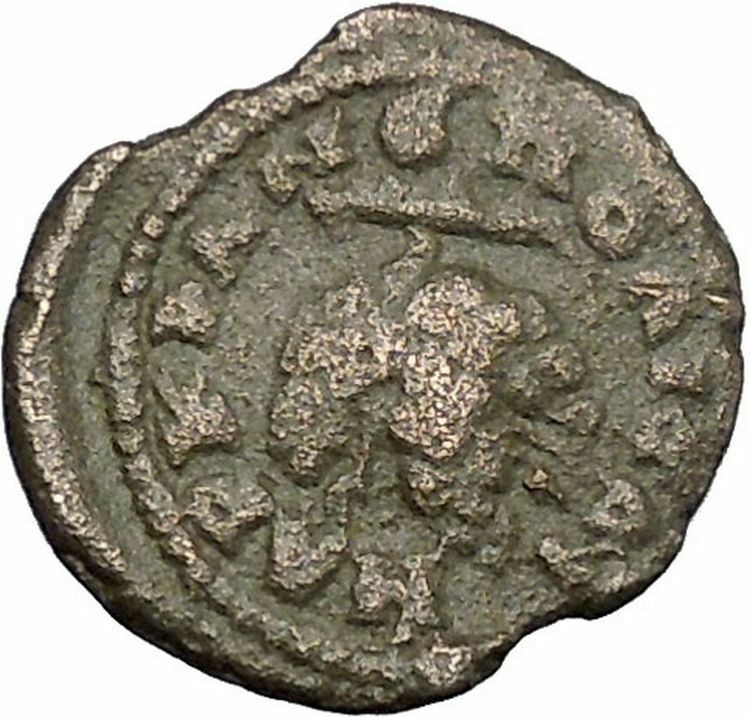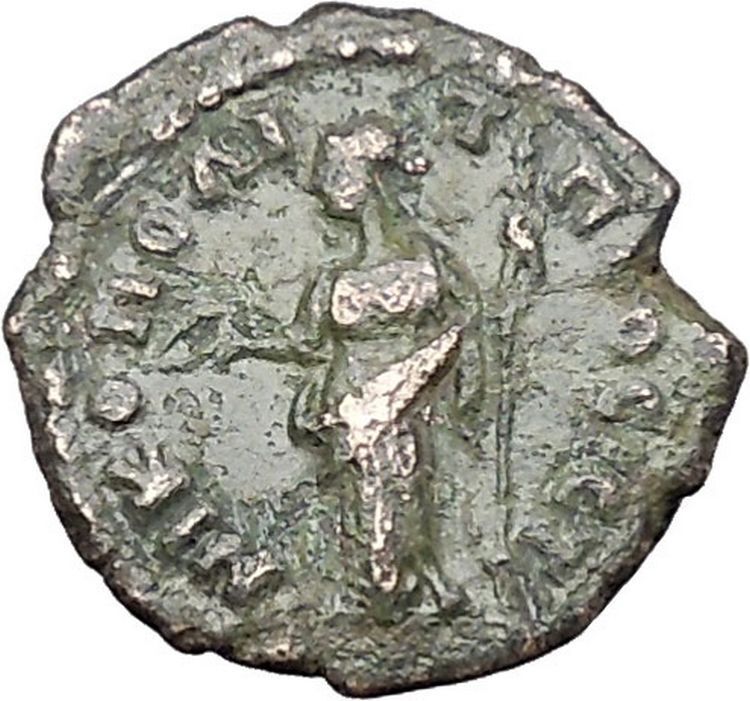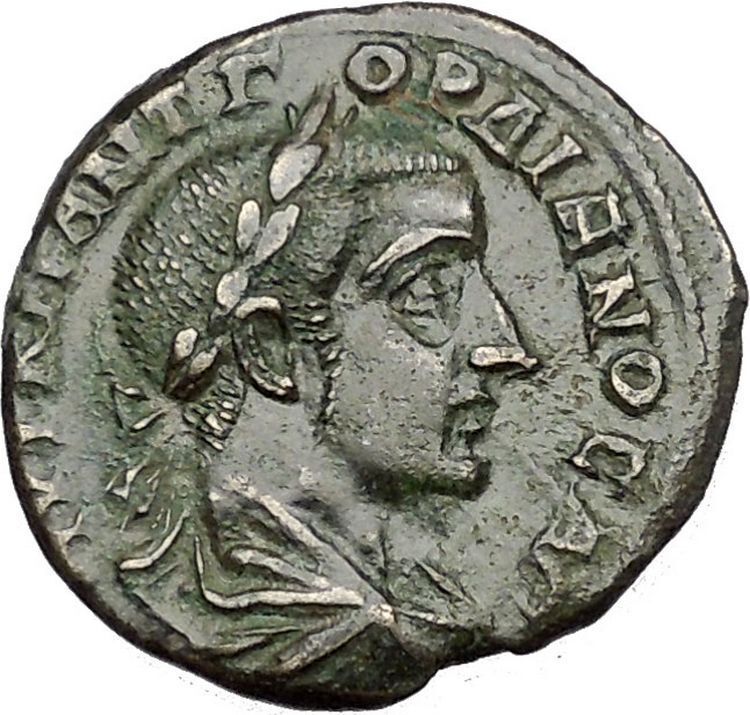|
Trebonianus Gallus – Roman Emperor : 251-253 A.D.
Bronze 23mm (6.30 grams) Deultum in Thrace
Reference: Bellinger A412. Rare.
IMP VIB TREB GALLVS AV, Laureate, draped and cuirassed bust of Trebonianus Gallus to right.
COL AVG TROAD, Satyr Marsyas standing right, raising his left hand and holding wine-skin over his right shoulder.
You are bidding on the exact item pictured, provided with a Certificate of Authenticity and Lifetime Guarantee of Authenticity.
 In Greek mythology, the satyr Marsyas is a central figure in two stories involving death: in one, he picked up the double flute (aulos) that had been abandoned by Athena and played it; in the other, he challenged Apollo to a contest of music and lost his hide and life. In Antiquity, literary sources often emphasise the hubris of Marsyas and the justice of his punishment. In Greek mythology, the satyr Marsyas is a central figure in two stories involving death: in one, he picked up the double flute (aulos) that had been abandoned by Athena and played it; in the other, he challenged Apollo to a contest of music and lost his hide and life. In Antiquity, literary sources often emphasise the hubris of Marsyas and the justice of his punishment.
In one conjunction Rhea/Cybele, and his episodes are situated by the mythographers in Celaenae (or Kelainai) in Phrygia (today, the town of Dinar in Turkey), at the main source of the Meander (the river Menderes).
When a genealogy was applied to him, Marsyas was the son of Olympus (son of Heracles and Euboea, daughter of Thespius), or of Oeagrus, or of Hyagnis. Olympus was, alternatively, said to be Marsyas’ son or pupil.
Alexandria Troas (“Alexandria of the Troad“, mod. Eski Stambul) is an ancient Greek city situated on the Aegean Sea near the northern tip of Turkey’s western coast, a little south of Tenedos (modern Bozcaada). It is located in the modern Turkish province of Çanakkale.
According to the Catholic Encyclopedia, this site was first called Sigia; perhaps about 310 BC Antigonus refounded the city as Antigonia Troas. In its early years, Troas was a port city that supplied the Dorians with resources and trade. The city was conquered by the Helladic people and was nearly destroyed. It was rebuilt early in the next century and the name was changed by Lysimachus to Alexandria Troas, in memory of Alexander III of Macedon (Pliny, N.H. 5.124 merely states that the name changed from Antigonia to Alexandria). As the chief port of north-west Asia Minor, the place prospered greatly in Roman times, and the existing remains sufficiently attest its former importance. Strabo mentions that a Roman colony was created at the location in the reign of Augustus, named Colonia Alexandria Augusta Troas (called simply Troas during this period). Augustus, Hadrian and the rich grammarian Herodes Atticus contributed greatly to its embellishment; the aqueduct still preserved is due to the latter. Constantine considered making Troas the capital of the Roman Empire.
In Roman times, it was a significant port for travelling between Anatolia and Europe. Paul of Tarsus sailed for Europe for the first time from Alexandria Troas (Acts, 16:8-11) and returned there from Europe (and there occurred later the episode of the raising of Eutychus (Acts 20:5-12). Ignatius of Antioch also paused at this city before continuing to his martyrdom at Rome (Ad Philad. 11.2; Ad Smyrn. 12.1).
Several of its later bishops are known: Marinus in 325; Niconius in 344; Sylvanus at the beginning of the fifth century; Pionius in 451; Leo in 787; Peter, friend of the Patriarch Ignatius, and adversary to Michael, in the ninth century. In the tenth century Troas is given as a suffragan of Cyzicus and distinct from the famous Troy (Heinrich Gelzer, Ungedruckte … Texte der Notitiae episcopatuum, 552; Georgii Cyprii descriptio orbis romani, 64); it is not known when the city was destroyed and the diocese disappeared. The city remains a titular see of the Roman Catholic Church, Troadensis; the seat is vacant following the resignation of the last bishop in 1971. Troas is also a titular see of the Orthodox Church under the Ecumenical Patriarchate; the current hierarch is His Grace Bishop Savas (Zembillas) of Troas.
The site as of 1911 was covered with vallonea oaks, and has been much plundered (for example Mehmed IV took columns to adorn his new Valideh mosque in Istanbul), but the circuit of the old walls can be traced, and in several places they are fairly well preserved. They had a circumference of about ten kilometres, and were fortified with towers at regular intervals. Remains of some ancient buildings, including a bath and gymnasium, can be found within this area. Trajan built an aqueduct which can still be traced. The harbour had two large basins, now almost choked with sand. It is the subject of a recent study by German archaeologists who are digging and surveying at the site.
 Gaius Vibius Trebonianus Gallus (206 – August, 253), was Roman Emperor from 251 to 253, in a joint rule with his son Volusianus. Gaius Vibius Trebonianus Gallus (206 – August, 253), was Roman Emperor from 251 to 253, in a joint rule with his son Volusianus.
Gallus was born in Italy, in a family with respected ancestry of Etruscan senatorial background. He had two children in his marriage with Afinia Gemina Baebiana: Gaius Vibius Volusianus, later Emperor, and a daughter, Vibia Galla. His early career was a typical cursus honorum, with several appointments, both political and military. He was suffect consul and in 250 was nominated governor of the Roman province of Moesia Superior, an appointment that showed the confidence of emperor Trajan Decius in him. In Moesia, Gallus was a key figure in repelling the frequent invasion attacks by the Gothic tribes of the Danube and became popular with the army, catered to during his brief Imperial rule by his official image: military haircut, gladiatorial physique, intimidating stance (illustration, left).
In June 251, Decius and his co-emperor and son Herennius Etruscus died in the Battle of Abrittus, at the hands of the Goths they were supposed to punish for raids into the empire, largely owing to the failure of Gallus to attack aggressively. When the army heard the news, the soldiers proclaimed Gallus emperor, despite Hostilian, Decius’ surviving son, ascending the imperial throne in Rome. Gallus did not back down from his intention to become emperor, but accepted Hostilian as co-emperor, perhaps to avoid the damage of another civil war. While Gallus marched on Rome, an outbreak of plague struck the city and killed young Hostilian. With absolute power now in his hands, Gallus nominated his son Volusianus co-emperor.
Eager to show himself competent and gain popularity with the citizens, Gallus swiftly dealt with the epidemic, providing burial for the victims. Gallus is often accused of persecuting the Christians, but the only solid evidence of this allegation is the imprisoning of Pope Cornelius in 252.
Like his predecessors, Gallus did not have an easy reign. In the East, Persian Emperor Shapur I invaded and conquered the province of Syria, without any response from Rome. On the Danube, the Gothic tribes were once again on the loose, despite the peace treaty signed in 251. The army was not long pleased with the emperor, and when Aemilianus, governor of Moesia Superior and Pannonia, took the initiative of battle and defeated the Goths, the soldiers proclaimed him emperor. With a usurper threatening the throne, Gallus prepared for a fight. He recalled several legions and ordered reinforcements to return to Rome from the Rhine frontier. Despite these dispositions, Aemilianus marched onto Italy ready to fight for his claim. Gallus did not have the chance to face him in battle: he and Volusianus were murdered by their own troops in August 253, in Interamna (modern Terni).
|





 In Greek mythology, the satyr Marsyas is a central figure in two stories involving death: in one, he picked up the double flute (aulos) that had been abandoned by Athena and played it; in the other, he challenged Apollo to a contest of music and lost his hide and life. In Antiquity, literary sources often emphasise the hubris of Marsyas and the justice of his punishment.
In Greek mythology, the satyr Marsyas is a central figure in two stories involving death: in one, he picked up the double flute (aulos) that had been abandoned by Athena and played it; in the other, he challenged Apollo to a contest of music and lost his hide and life. In Antiquity, literary sources often emphasise the hubris of Marsyas and the justice of his punishment. Gaius Vibius Trebonianus Gallus (206 – August, 253), was Roman Emperor from 251 to 253, in a joint rule with his son Volusianus.
Gaius Vibius Trebonianus Gallus (206 – August, 253), was Roman Emperor from 251 to 253, in a joint rule with his son Volusianus.




